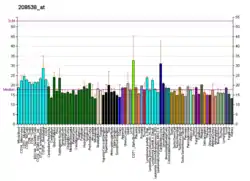ANP32C
Acidic leucine-rich nuclear phosphoprotein 32 family member C is a protein that in humans is encoded by the ANP32C gene.[3][4][5]
| ANP32C | |||||||||||||||||||||||||
|---|---|---|---|---|---|---|---|---|---|---|---|---|---|---|---|---|---|---|---|---|---|---|---|---|---|
| Identifiers | |||||||||||||||||||||||||
| Aliases | ANP32C, PP32R1, acidic nuclear phosphoprotein 32 family member C | ||||||||||||||||||||||||
| External IDs | OMIM: 606877 HomoloGene: 49316 GeneCards: ANP32C | ||||||||||||||||||||||||
| |||||||||||||||||||||||||
| |||||||||||||||||||||||||
| |||||||||||||||||||||||||
| Orthologs | |||||||||||||||||||||||||
| Species | Human | Mouse | |||||||||||||||||||||||
| Entrez |
| ||||||||||||||||||||||||
| Ensembl |
| ||||||||||||||||||||||||
| UniProt |
| ||||||||||||||||||||||||
| RefSeq (mRNA) |
| ||||||||||||||||||||||||
| RefSeq (protein) |
| ||||||||||||||||||||||||
| Location (UCSC) | Chr 4: 164.2 – 164.2 Mb | n/a | |||||||||||||||||||||||
| PubMed search | [2] | n/a | |||||||||||||||||||||||
| Wikidata | |||||||||||||||||||||||||
| |||||||||||||||||||||||||
Function
Phosphoprotein 32 (PP32) is a tumor suppressor that can inhibit several types of cancers, including prostate and breast cancers. The protein encoded by this gene is one of at least two proteins that are similar in amino acid sequence to PP32 and are part of the same acidic nuclear phosphoprotein gene family. However, unlike PP32, the encoded protein is tumorigenic. The tumor suppressor function of PP32 has been localized to a 25 amino acid region that is divergent between PP32 and the protein encoded by this gene. This gene does not contain introns.[5]
References
- GRCh38: Ensembl release 89: ENSG00000248546 - Ensembl, May 2017
- "Human PubMed Reference:". National Center for Biotechnology Information, U.S. National Library of Medicine.
- Kadkol SS, Brody JR, Pevsner J, Bai J, Pasternack GR (March 1999). "Modulation of oncogenic potential by alternative gene use in human prostate cancer". Nature Medicine. 5 (3): 275–9. doi:10.1038/6488. PMID 10086381. S2CID 24559649.
- Brody JR, Kadkol SS, Mahmoud MA, Rebel JM, Pasternack GR (July 1999). "Identification of sequences required for inhibition of oncogene-mediated transformation by pp32". The Journal of Biological Chemistry. 274 (29): 20053–5. doi:10.1074/jbc.274.29.20053. PMID 10400610.
- "Entrez Gene: ANP32C acidic (leucine-rich) nuclear phosphoprotein 32 family, member C".
Further reading
- Matilla A, Radrizzani M (2005). "The Anp32 family of proteins containing leucine-rich repeats". Cerebellum. 4 (1): 7–18. doi:10.1080/14734220410019020. PMID 15895553. S2CID 39153579.
- Kochevar GJ, Brody JR, Kadkol SS, Murphy KM, Pasternack GR (June 2004). "Identification of a functional mutation in pp32r1 (ANP32C)". Human Mutation. 23 (6): 546–51. doi:10.1002/humu.20030. PMID 15146458. S2CID 38677421.
- Fan Z, Beresford PJ, Zhang D, Xu Z, Novina CD, Yoshida A, Pommier Y, Lieberman J (February 2003). "Cleaving the oxidative repair protein Ape1 enhances cell death mediated by granzyme A". Nature Immunology. 4 (2): 145–53. doi:10.1038/ni885. PMID 12524539. S2CID 29433133.
- Kadkol SS, El Naga GA, Brody JR, Bai J, Gusev Y, Dooley WC, Pasternack GR (July 2001). "Expression of pp32 gene family members in breast cancer". Breast Cancer Research and Treatment. 68 (1): 65–73. doi:10.1023/A:1017919507109. PMID 11678310. S2CID 11915912.
- Bai J, Brody JR, Kadkol SS, Pasternack GR (April 2001). "Tumor suppression and potentiation by manipulation of pp32 expression". Oncogene. 20 (17): 2153–60. doi:10.1038/sj.onc.1204294. PMID 11360199. S2CID 8755931.
- Kadkol SS, Brody JR, Pevsner J, Bai J, Pasternack GR (September 1999). "Correction to "Modulation of oncogenic potential by alternative gene use in human prostate cancer"". Nature Medicine. 5 (9): 1087. doi:10.1038/12530. PMID 10471270.
This article is issued from Wikipedia. The text is licensed under Creative Commons - Attribution - Sharealike. Additional terms may apply for the media files.


